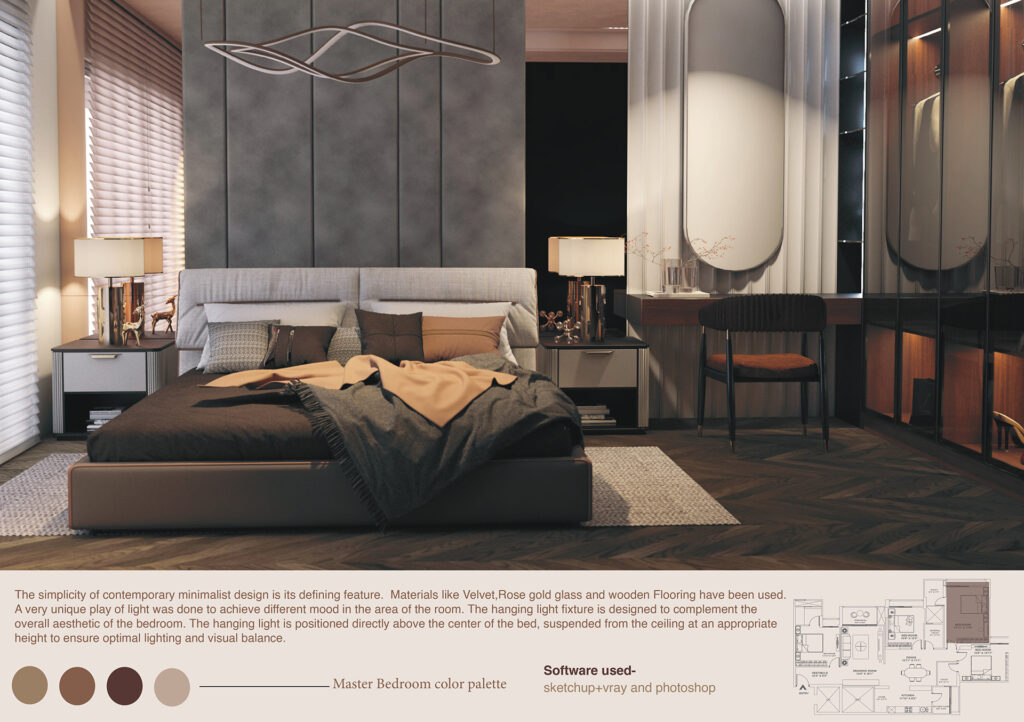Creating a bedroom is an exciting and deeply personal experience. As the place where you begin and end each day, it should reflect your unique style, foster relaxation, and offer maximum comfort. To help you design a space that truly feels like a sanctuary, here are some key considerations to keep in mind.

1. Define Your Style
- Personal Taste: Your bedroom should be a reflection of your personality. Whether you prefer a minimalist design, a cozy rustic feel, or a luxurious modern look, make sure the design aligns with your tastes.
- Mood and Atmosphere: Think about the mood you want to create. Soft, muted tones can promote calmness, while bolder colors can add energy and vibrancy to the space.
2. Prioritize Comfort
- The Bed: The bed is the centerpiece of the bedroom. Invest in a good-quality mattress and bedding to ensure a comfortable and restful sleep. The size of the bed should be proportionate to the room to avoid a cramped feeling.
- Seating Area: If space allows, consider adding a comfortable chair or a small loveseat. This can serve as a reading nook or just a place to relax without having to be in bed.
3. Consider Functionality
- Storage Solutions: Efficient storage is key in a bedroom. Incorporate built-in wardrobes, under-bed storage, or a dresser to keep the room organized and clutter-free.
- Multi-Functional Furniture: If you’re working with a smaller space, choose furniture that serves multiple purposes. For example, a bed with drawers underneath or a nightstand with extra storage can be very practical.
4. Lighting Matters
- Layered Lighting: Combine different types of lighting to create a balanced atmosphere. Use ambient lighting for overall illumination, task lighting for reading or working, and accent lighting to highlight artwork or architectural features.
- Natural Light: Maximize natural light by using light-colored window treatments that allow light to filter through. Consider the placement of mirrors to reflect natural light and make the room feel larger and brighter.
5. Color Palette
- Soothing Colors: Choose colors that promote relaxation and sleep. Neutrals, pastels, and earth tones are great choices for a bedroom. They create a calm and serene environment.
- Accent Colors: You can introduce accent colors through accessories like throw pillows, rugs, or artwork. This allows you to add personality without overwhelming the space.
6. Textures and Fabrics
- Soft Textures: Incorporate soft, cozy textures like plush rugs, velvet cushions, and knitted throws to add warmth and comfort to the room.
- Layering Fabrics: Layering different fabrics can add depth and interest to your design. Mix and match materials like linen, cotton, and wool to create a luxurious and inviting atmosphere.
7. Personal Touches
- Artwork and Decor: Personalize your space with artwork, photographs, or decor items that have special meaning to you. These elements can make your bedroom feel more intimate and uniquely yours.
- Greenery: Adding plants can bring life and freshness to your bedroom. Choose low-maintenance plants that thrive in indoor environments.
8. Spatial Layout
- Flow and Accessibility: Consider the layout of the room to ensure that there is a good flow and that the space feels open and accessible. Avoid placing furniture in a way that blocks pathways or makes the room feel cramped.
- Balance: Ensure that the furniture placement is balanced and symmetrical to create a harmonious and visually pleasing environment.
9. Technology Integration
- Smart Solutions: Incorporate technology seamlessly by using smart lighting, automated window treatments, or a hidden TV. This keeps the bedroom modern and functional without compromising its aesthetic.
- Charging Stations: Ensure there are convenient places to charge your devices, either through bedside tables with built-in chargers or strategically placed outlets.
10. Sustainability
- Eco-Friendly Materials: Consider using sustainable and eco-friendly materials in your bedroom design. This could include organic bedding, reclaimed wood furniture, or non-toxic paints.
- Energy Efficiency: Choose energy-efficient lighting and consider installing a programmable thermostat to maintain a comfortable temperature while saving energy.
Conclusion
Designing a bedroom is about creating a space that resonates with you personally. By focusing on comfort, functionality, and aesthetics, you can design a bedroom that not only looks beautiful but also serves as a restful retreat. Remember to incorporate personal touches and consider the overall flow of the space to make it uniquely yours. Happy designing!